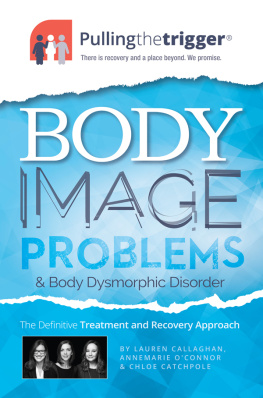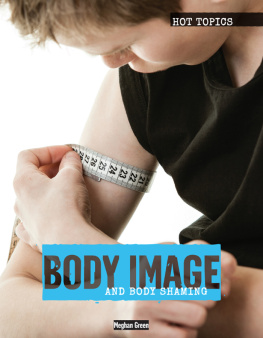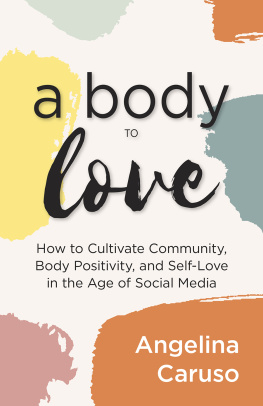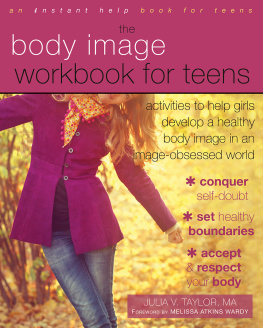Published in 2018 by The Rosen Publishing Group, Inc.
29 East 21st Street, New York, NY 10010
Copyright 2018 by The Rosen Publishing Group, Inc.
First Edition
All rights reserved. No part of this book may be reproduced in any form without permission in writing from the publisher, except by a reviewer.
Library of Congress Cataloging-in-Publication Data
Names: Chomet, Natalie, author.
Title: Coping with body shaming / Natalie Chomet.
Description: New York, NY : Rosen Publishing, 2018. | Series: Coping |
Includes bibliographical references and index. | Audience: Grades 7-12.
Identifiers: LCCN 2017014238 | ISBN 9781508176879 (library bound) | ISBN 9781508178491 (paperback)
Subjects: LCSH: Body image Juvenile literature. | Shame Juvenile
literature. | Criticism, PersonalJuvenile literature. | CourtesyJuvenile literature.
Classification: LCC BF697.5.B63 C46 2018 | DDC 306.4/613dc23
LC record available at https://lccn.loc.gov/2017014238
Manufactured in the United States of America
Contents
INTRODUCTION
I ts the 2017 Super Bowl halftime show, and Lady Gaga enters onto the field from above, suspended from a line. Her performance was a spectacle, as any halftime show should be, and it involved several costume changes, one of which included a crop top that exposed her midriff. Though her performance was a feat that showcased both her aerobic and vocal abilities, many of those who responded focused on one thing: her bare stomach. Body shamers took to the internet and commented on her belly via Twitter and Facebook, with comments that disparaged her for showing her stomach when it wasnt presentable enough by their standards. Conversely, many fans lashed out in response, commenting that her choice to show her less-than-perfect body was inspirational to them. Lady Gaga herself responded on Instagram with the comment, I heard my body is a topic of conversation so I wanted to say, Im proud of my body and you should be proud of yours too. The bottom line is that despite all the other aspects of her performance viewers could have focused on, her stomach became the focus becausethough practically flatit was still bigger than what we are accustomed to seeing in popular culture.

Body shaming is all around us; it comes from many directions and may take many forms. Superstar, supermodel, or super-normal, no one is exempt. No matter who you are or what you look like, chances are there have been times when you have been made to feel that your body is not normal, acceptable, or good enough. According to Harriet Browns book, Body of Truth, in the first six months of 2014, a Google search for the word obesity resulted in twenty-seven million hits. The same Google search performed in February of 2017 comes up with eighty-seven million. Though not a scientific standard by any means, this shows our societys growing preoccupation with weight.
To be clear, shame over ones body is not confined to weight alone by any means, though it is a common focus for both men and women alike. Women and men of different races, sexual preferences, and cultures all navigate a complex and varied set of expectations regarding their appearance. Body shame, defined simply, is the result of someone making a person feel his or her body is not correct based on whatever standards of beauty the shamer may hold. Though anyone can be the target of body shaming, teens are in a unique position in this regard. As a teenager, you go through various stages of development. Puberty changes the body in gradual and dramatic ways, and it is hard enough to adjust to it on your own without the scrutiny of anyone else. The fact that each persons body goes through these changes at different paces and in different ways makes for more opportunities to compare and pass judgment. Who is growing a beard or needs a bra at the right time," and who is supposedly late to the game? Social media only adds to this pressure and anxiety. The constant loop of sharing selfies and getting commentsboth validating and disparagingall based on your appearance makes it hard not to focus and pass judgment on your looks. So, how can you deal with it?

W hat do you see when you look in the mirror? Note if you automatically focus on things that you view as flaws and what they are. Body shaming can focus on the obvious and most prevalent things, such as weight or perceived fat, or small things, such as if your thighs touch when you stand straight, how tall you are, or if you have visible six-pack abs. The ideals of what is beautiful or handsome change based not just on gender but also on your cultural background.
Mirror, Mirror
In the United States, we tend to be concerned with slim bodies and bronzed, wrinkle-free skin. Around the world, other standards prevail: the Kayan tribe in Thailand consider women with long necks beautiful; the Karo tribe in Ethiopia performs decorative scarring on womens bodies. A Photoshop experiment revealed that in Serbia, men with tattoos are considered attractive, while in South Africa, men with dark skin and defined abs are considered attractive. As a teen, there are so many phases that you go through physically, chances are you arent 100 percent comfortable in your own skin without all the added outside pressure!

Seeking the "Perfect Post-Baby Body
Theres also the added pressure for women to get back into shape quickly after pregnancy. Many celebritiesincluding Kim Kardashian, Kate Hudson, and Kate Middleton, to name a fewhave been shamed in the media for not having the ideal body after a pregnancy. Or on the flip side, a celebrity who gets her beach body back quickly after a pregnancy is praised in the media. This perpetuates an unhealthy and unrealistic expectation for new moms. Celebrities will have much more access to resources that will help them achieve this goal: nannies, personal trainers, dietitians, and more. Most people wont be able to spend six hours a day doing cardio and yoga routines to snap back into shape right after having a baby. And why should they even want to? It perpetuates both an unrealistic goal and an emphasis on appearance over well-being. A new mom should instead be focusing on letting her postpartum body recover, her health, and the health of a new baby.
Women in particular are subject to pressure to conform to many beauty ideals that seem nearly impossible to exist in one single body at once: small waist, large breasts (but not too large), a gap between skinny thighs, but also a curvy backside (but not too prominent). If women all believed they needed to have every one of these attributes, who wouldnt look in the mirror and find they came up short?
It isnt only girls and women who are often dissatisfied with their bodies. Boys and men feel the pressure, too. For both girls and guys, the overexposure to images of bodies considered to be ideal takes its toll on body image and self-esteem. Boys and men are increasingly unhappy with their own bodies for one reason or another (most often because of a perceived lack of muscularity). In 2012, 90 percent of teen boys exercised with the specific goal of bulking up, and all signs point to this trend increasing over time, according to an article for
















